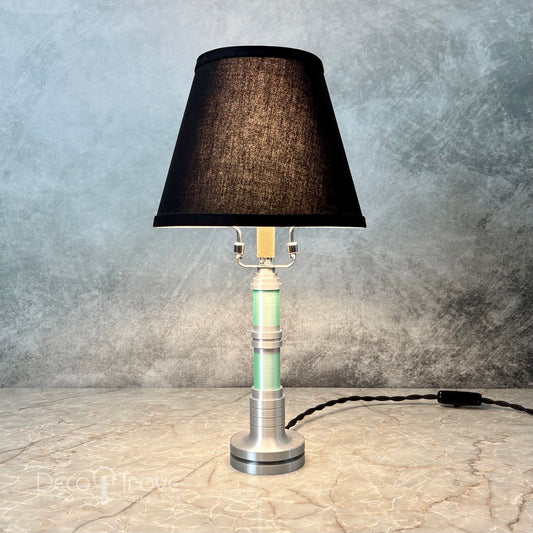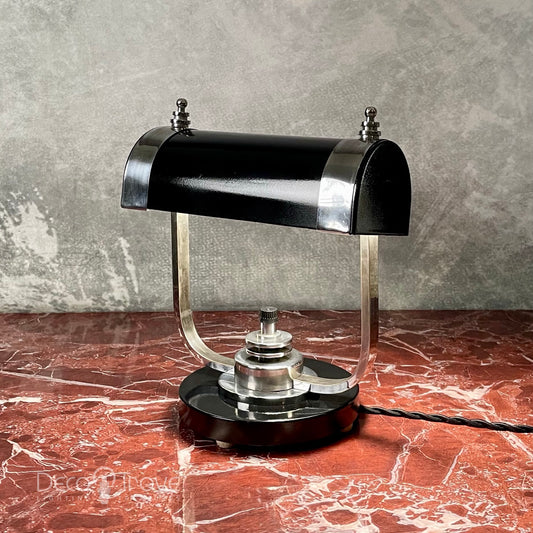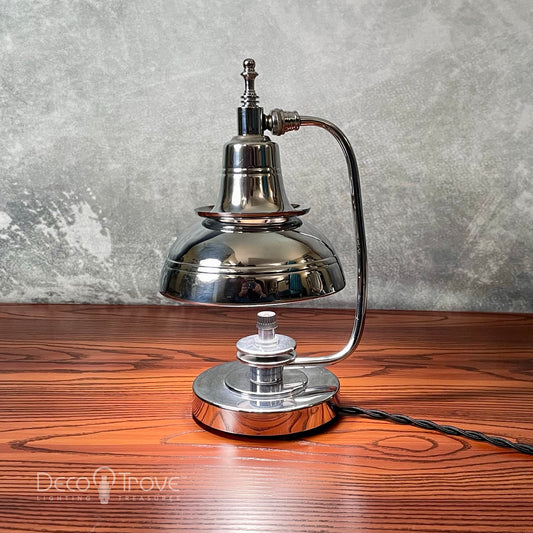Uncovering The History of Pattyn Products
Partager
Among design collectors, Pattyn Products lamps are considered some of the finest examples of early 20th-century American modern design. The company successfully created iconic lighting that bridges multiple styles, from Art Deco and Streamline Moderne to Mid-Century Modern.
Pattyn Products (later Modern Products Corporation) was one of the most intriguing small manufacturers of the 1940s. The company produced several renowned Streamline Moderne and Bauhaus-influenced lamps, which now appear in private collections and prestigious museums across the U.S., including the Minneapolis Institute of Art, Cooper Hewitt, Kirkland Museum of Fine & Decorative Art, MoMA, and the Metropolitan Museum of Art.


Pattyn Products Lamp model 310, (c1946) - Pattyn Products. Photo from collection of Author.
Introduction
The company utilized some of the best new materials of the era, such as Bakelite, a very early phenolic resin-based plastic, Micarta (phenolic laminate), Lucite, and spun aluminum. Pattyn lamp designs often featured an innovative blend of modern and traditional materials, such as Bakelite and brass, arranged in horizontal bands. This emphasis on horizontal lines strongly reflected the Streamline Moderne aesthetic, evoking a sense of speed and movement.
Several lamp designs utilized an intriguing and novel way to diffuse and direct light through a series of discs and frosted glass. This diffusion technique is very reminiscent of early designs by German-American designer Walter von Nessen, which appear in the August 1930 issue of House Beautiful (Nessen Studio 161). A close-up view of a similar lamp was featured in the August 1930 issue of House & Garden (Kahn 46). Many museums and auction houses have attributed the model 310 lamp design to Walter von Nessen under contract for Pattyn Products.
The design closely resembles von Nessen’s earlier work, but there is currently no documentation to confirm the attribution to him. The earliest known record of this lamp dates to March 1946, three years after von Nessen’s death in 1943. While this does not definitively confirm or refute the attribution, it highlights the need for more extensive research to clarify the lamp’s origins.

Walter von Nessen - Nessen Lighting.

Glass & Disc Desk Lamp, Walter von Nessen - (1930) - (Nessen Studio 161).

Close-up of Glass & Disc Desk Lamp, Walter von Nessen - (1930) - (Kahn 46).
About Pattyn Products
Despite the possible designer’s prominence and the firm’s recognition among collectors and museums, little is truly known about the Mo-Town company responsible for producing many of these remarkable lamp designs.
Pierre Paul Pattyn, a Belgian-American immigrant born on February 16, 1902, founded Pattyn Products in Detroit, Michigan, in 1942, with his younger brother Julian Rene Pattyn, born on December 15, 1914, as his business partner (The Directory 208).
Little is known about the company’s early years but its founding coincided with the United States’ entry into World War II, a time when there was a high demand for aluminum and skilled machinists to support the war effort. While it’s not definitively known whether Pierre and his brother originally set out to produce lighting and household goods, the timing of the company’s founding during World War II suggests it may have been established primarily to support the war effort. Throughout much of his life, Pierre Pattyn was an entrepreneur and inventor, founding and managing several companies while securing numerous patents for inventions ranging from electronic musical instruments and board games to electrical components.

Pattyn Products in The Directory of Michigan Manufacturers - (1946) - (The Directory 208).
One of Pierre’s first successes was a venture called Michigan Radio Parts, which later became U.S. Radio Products, Inc. Founded in the mid-1930s, the company specialized in designing and manufacturing radio components and seemed to be thriving by 1939. In fact, Pierre placed an ad in Radio News that year with the headline “HELP! YOU HAVE SWAMPED US.” The ad informed customers that demand for their RX-18 all-wave tuning assembly had far surpassed expectations, leading the company to expand into a new manufacturing facility. This move would also allow them to introduce a full range of new products (Radio News 52).
Pattyn Products went through several different phases and changed name a few times over the years to keep up with its shifting market focus. It was first known as Pattyn Machine Shop - possibly due to WWII
The company maintained its main location at 11840 Harper Avenue and branch plant at 11808 Harper Avenue as of 1946
Pierre and his brother Julian were charged years later with failure to pay property taxes assessed on the location at 11840 Harper Avenue in 1946 by the city of Detroit (Proceedings 915). The company moved to a location at 8026 Kercheval St (Modern Products Corporation 75), then to a location in Cadillac Tower at 65 Cadillac Square in July 1950 (Modern Products Corporation 167), and finally to a location at 1349 East Milwaukee Ave (“Modern Products Corp., Bankrupt” 28).
Likely in an effort to diversify the business, Pattyn began experimenting with other inventions, most notably games and electronic musical instruments. Most of the patents held by Pattyn are related to several of his musical inventions. It was during these efforts in 1951 while Pierre was in the process of manufacturing a new type of instrument, he was arrested and charged with unlawful stock sales. A flood of investors angry about the slow timeline to roll out the new instrument brought the issue to the prosecutors office (“Broker-Inventor Held” 7).

Pierre P. Pattyn from Detroit Free Press Article (Sep 15, 1951) - (“Broker-Inventor Held” 7).
It’s unclear whether Pierre Pattyn directly contributed to the design of the iconic lighting his company became known for, or if the designs were created solely by employees or outside contractors. The same uncertainty applies to his brother and co-founder, Julian—while both played significant roles in the company’s success, their involvement in the actual design work is not well documented. However, a 1950 census reveals that Julian described his role as a machinist, highlighting his technical contribution to the business (“Detroit, Wayne, Michigan, United States Records”).
The only known lighting patent that was issued to Pierre Pattyn was a 1952 patent for a three-way push button switch

Pierre P. Pattyn Patent for Push-Button Multiple Switch (Oct 7, 1952) - (Pattyn Push-Button Multiple Switch).
Pattyn's Modern Products Company filed for bankruptcy and was liquidated through an announcement in the Detroit Free Press on Dec 2, 1951. The newspaper listed the court-ordered sale of assets that included: "Alum. Lamp Standards, Top Spacers, Discs, Plates, Rings, Lamp Shade Parts..." (“Modern Products Corp., Bankrupt” 28).

Bankruptcy & Liquidation Announcement in the Detroit Free Press. (“Modern Products Corp., Bankrupt” 28).
Documented Lamp Designs
The most well-known and celebrated lamp by Pattyn Products is the iconic model 310, a striking example of late Streamline Moderne design. Its bold form features a six-disc stacked shade surrounding a frosted glass cylinder, casting a diffused, ambient glow. The lamp’s spun aluminum body rises in a series of elegant, stepped forms and is accented with thin brass rings and alternating red and black Bakelite bands, which wrap around the shaft in crisp, symmetrical layers. Stepped brass finials adorn the top and bottom of the shade assembly.
The model 310 appears in a full advertisement published in the Detroit Free Press on March 31, 1946, marking its earliest known appearance in the public eye. In the photograph, the lamp is styled alongside a Chase “Crescent” bookend — a well-known design by Walter von Nessen from around 1935, discontinued by 1942 due to wartime restrictions on metal. While von Nessen’s involvement in the 310’s design is unconfirmed, it was common practice in product photography of the era to pair objects by the same or similarly styled designers to appeal to modernist sensibilities.
Although some museum records and appraisals have attributed the model 310 lamp to 1935–1936, this timeline conflicts with established historical facts. While the lamp’s Streamline Moderne design — with its stepped forms, contrasting materials, and layered geometric motifs — is consistent with the aesthetics of the mid-1930s, it is, in reality, a product of postwar America.
Pattyn Products, originally operating as Pattyn Machine Shop, was not founded until 1942. At that time, the United States was entering World War II, and aluminum was classified as a strategic material, with strict restrictions placed on its civilian use. Given both the company’s founding date and the wartime limitations on materials, the production of such a decorative aluminum lamp in the mid-1930s is impossible, and highly improbable during the early 1940s.
The model 310’s first documented appearance — in a March 1946 Detroit Free Press advertisement — places it squarely in the immediate postwar period, when civilian industries were rapidly shifting back to consumer goods and embracing futuristic, modernist designs that had been put on hold during the war.
In that March advertisement, the lamp was listed at $29.50, a price that reflects its initial retail strategy through established dealers. However, by June 1946, a Detroit News advertisement shows that the price had dropped significantly to $18.75 when Pattyn Products began marketing the lamp directly from the manufacturer. This shift in pricing not only made the lamp more accessible but also suggests a strategic move to expand reach and undercut traditional retail markups—a tactic in line with the postwar emphasis on mass-market affordability and streamlined distribution.


March 1946 Ad in the Detroit Free Press. (Left) (A. J. Doyle & Co. 94). June 1946 Ad in The Detroit News (Right) (… The Detroit News 94).
The advertisements below feature two different Pattyn lamps, each with unknown model numbers.
The lamp on the left is the same model featured in an additional advertisement and rare brochure (shown below). The base consists of a series of stepped circular sections. The column rises in a segmented, tiered shape, with cylindrical sections separated by narrower bands. This model is fairly uncommon but can be viewed at the Kirkland Museum of Fine and Decorative Art in Denver, Colorado.
The lamp on the right is even rarer. Its design features a tapered, spun form that leans slightly more toward traditional aesthetics while still reflecting Art Deco influences. This particular model is exceptionally rare, seldom appearing for sale or as part of museum collections.


Machined Aluminum Lamp Ad - Better Homes & Gardens July 1950

Photo of an extraordinarily rare Pattyn Products lamp brochure. Likely from the late 1940's or early 1950's. Posted to Facebook in 2016. (Stitt).
Design Variations
The 310 lamp comes in a few variations. Most have brass rings at the bottom, but some, like the one from the Carnegie Museum, do not. Another difference lies in the height of some sections and the chamfered edges, which likely changed during the production run. Some versions tend to have a shorter base and larger chamfers, while later, more common models are slightly taller with smaller chamfers.

Pattyn Products 310 Lamp variation that omits brass rings from the lower section. (Carnegie Museum of Art).
Other Attributed Lamps
It's not known how many different lamp models were designed by Pattyn Products but we are continually uncovering evidence that there was indeed a full line-up beyond the few lamps that advertising was found for.
The lamp below is part of our own collection and is currently available for purchase on our site. It features an inset aluminum body and a stepped base, closely echoing the design of the iconic Pattyn Products 310 lamp.

Spun Aluminum Lamp with Inset Line and Stepped Base, (c1947) - Unknown Manufacturer. Photo from Deco Trove LLC.
The table lamp shown below shares key design elements with both Pattyn Products and the work of Walter von Nessen. Its base and distinctive “separator neck” feature Micarta—a layered phenolic resin material—paired with Bakelite accents in horizontal bands, reminiscent of the styling seen on Pattyn’s 310 model. While the specific model number and documentation for this piece are currently unknown, its materials and construction strongly suggest a late 1940s origin.

The lamp pictured below features the same style of phenolic laminate base as the one above, along with matching inset details on the top of the aluminum body. Interestingly, it was purchased from an estate sale near the original location of Pattyn Products in Detroit, adding to its potential connection. The design may be incomplete, as the original socket and shade were missing at the time of purchase.

"Detroit Art Deco Lamp." (c1948) (Arondoski).
The lamp pictured below is a 1940s Streamline Deco design featuring a phenolic laminate base—likely Micarta—similar to those seen in the lamps above. It carries forward the same streamlined aesthetic, with a striking column of Lucite discs in graduated sizes, separated by inset spun aluminum sections accented with gold lines. The strong resemblance to designs attributed to Pattyn Products and similar manufacturers points to a possible connection. The use of Micarta, paired with layered construction and metallic detailing, reflects the era’s embrace of modern materials and sleek, machine-age styling.

Laminate and Aluminum w/Gold Inset Lamp, (c1948) - Unknown Manufacturer. Photo from collection of Author.
Pendant/Chandelier Lighting
While Pattyn is renowned for its iconic table lamp designs, what is lesser known is that the company also ventured into integrated lighting, including pendants and chandeliers. A rare documented example, shown below, retains its original label and offers a glimpse into this lesser-known side of Pattyn’s work. This pendant likely dates to the late 1940s or early 1950s, reflecting the company’s evolving design approach during that period.

Other Possible Products
It is often believed that Pattyn Products manufactured various household decor items from aluminum, Bakelite, and other materials. However, no documentation has been found to substantiate this claim. If a catalog, brochure, advertisement, or authentic label from the period were discovered, it might help verify some of these assertions. There has also been speculation about whether Pattyn Products was responsible for a pair of spun aluminum candlesticks that we found a few years ago, though no definitive evidence has emerged.

Spun Aluminum Streamline Deco Candlesticks - unknown manufacturer and designer, (c1940's). Photo from collection of Author.
** Please contact us if you have any additional information, advertisements, documentation, brochures, catalogs, patents, labels, etc about Pattyn Products or Modern Products Corporation. We would love to continue to update this post and educate others if and when more information becomes available. Thanks!
Acknowledgments:
We are deeply thankful to the staff at the Detroit Public Library, particularly the archivists in the Burton Historical Collection, for their expert guidance and assistance in accessing primary source materials that were essential to this research.
Works Cited:
A. J. Doyle & Co. “Advertisement for Pattyn Products Lamp” Detroit Free Press, 31 Mar. 1946, p. 94.
The Detroit News, 9 June 1946, p. 94. Access World News, https://infoweb-newsbank-com.eu1.proxy.openathens.net/apps/news/document-view?p=AMNEWS&docref=image/v2%3A143B808DB2B45FAC%40EANX-NB-145A25DD33C79531%402431981-145A0EC76165A53B%4093-145A0EC76165A53B%40.
Nessen Studio. “Lamps That Might Fittingly Be Characterized As Tailor-Made.” House Beautiful, vol. 68, no. 2, Aug. 1930, p. 161.
Kahn, Jacques. “Modern Lighting Departs Radically From The Methods Of The Past.” House & Garden, Aug. 1930, p. 46.
“U.S. Radio Products, Inc. Advertisement.” Radio News, vol. 22, no. 2, Aug. 1939, p. 52. Internet Archive, https://archive.org/details/sim_radio-television-news_1939-08_22_2/page/52/mode/2up?q=%22pierre+p+pattyn%22. Accessed 2 Oct. 2024.
Carnegie Museum of Art. Object: Table Lamp. Carnegie Museum of Art, https://collection.carnegieart.org/objects/8fd4f848-0b8f-4445-b03e-38cc0cb8b12e. Accessed 21 Sept. 2024.
Modern Products Corporation. “
Stitt, Mike. “Pattyn Products Lamp Brochure” Facebook, 28 Sept. 2016, www.facebook.com/photo.php?fbid=10207566252582153&set=p.10207566252582153&type=3. Accessed 2 Oct. 2024.
The Directory of Michigan Manufacturers. United States, Manufacturer Publishing Company, 1946, p. 208.
“New Charters Filed.” The News Journal, 16 Sept. 1949, p. 22.
“Modern Products Corp., Bankrupt.” Detroit Free Press, 2 Dec. 1951, p. 28.
Proceedings of the Common Council of the City of Detroit, p. 915.
Pattyn, Pierre P. Push-Button Multiple Switch. 7 Oct. 1952.
“Detroit, Wayne, Michigan, United States Records.” FamilySearch, images, National Archives and Records Administration, 18 Apr. 2025, www.familysearch.org/ark:/61903/3:1:3QHN-PQHW-P97Q-X?view=index. Image Group Number: 108986279.
Arondoski, Ray III. Photograph of Art Deco Lamp. Instagram, 23 May. 2024, https://www.instagram.com/p/C7VS5OFu1ah/. Accessed 2 Oct. 2024.
Unknown User. Photograph of a vintage pendant lamp. Facebook, 15 Mar. 2022, www.facebook.com/groups/1572436159678358/permalink/2884724468449514/. Accessed 17 June 2024.
Modern Products Corporation. “Advertisement for Pattyn Lamps.” House Beautiful, May 1950, p. 75.
Modern Products Corporation. “
“Broker-Inventor Held in $106,500 Stock Deal.” Detroit Free Press, 15 Sept. 1951, p. 7.













